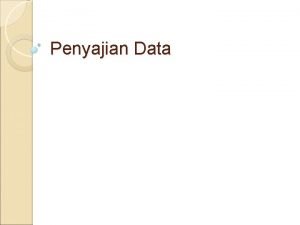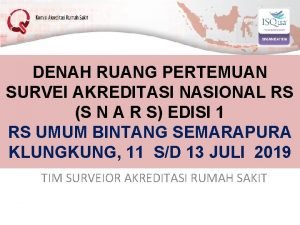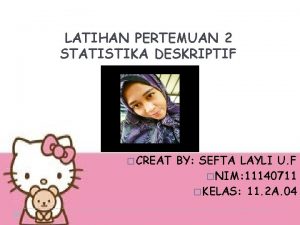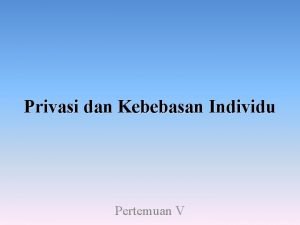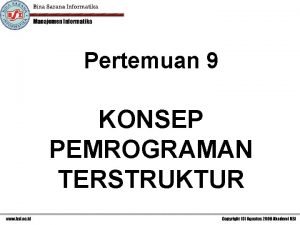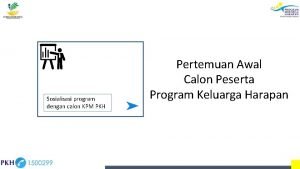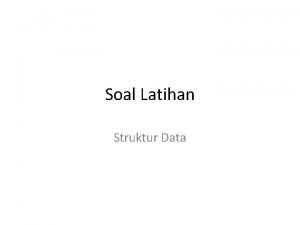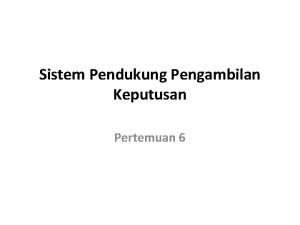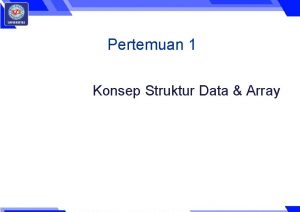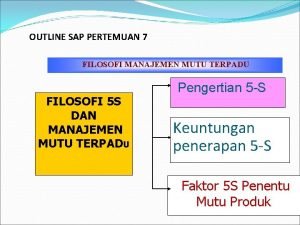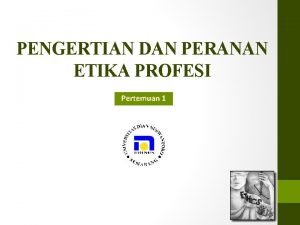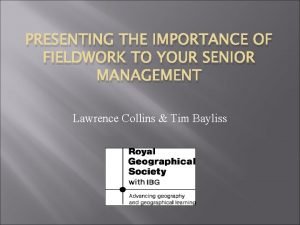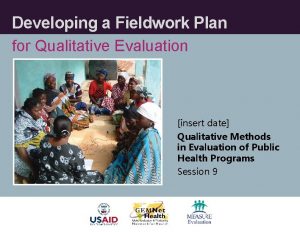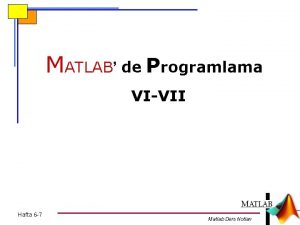Field Work PERTEMUAN VIVII Dr Rilla Gantino SE



































- Slides: 35

Field Work PERTEMUAN VI-VII Dr Rilla Gantino, SE. , AK. , MM MAKSI-FEB

KEMAMPUAN AKHIR YANG DIHARAPKAN - Mampu mejelaskan proses dan tujuan dari Field Work Memahami audit fungsional Memahami audit organisasional Memahami studi manajemen Memahami audit program

Carry out fieldwork as indicated in the annual audit plan. Obtain cooperation from the management and the staff as necessary to identify, obtain documentation and conduct interviews, etc. Conduct fieldwork with minimal disruption to operations of the company being audited. Build friendly environment with the management.

RISK COMPOSITION Internal audit has a responsibility to cover financial, operational, information system, legal/regulatory and all other risks that may have significant impact on the business of an entity.

Risk identification Expert interviews with management personnel Risk assessment meetings with the relevant persons Review of previous risk assessment working papers by I/A department Filling detailed questionnaires for adequate existence of internal controls Ensuring the appropriateness of these questionnaires in alignment with the operations of the company Carefully reviewing the results of internal audit questionnaires and marking red flags where serious control violations are found Reviewing management working papers for risk assessments made by them Reviewing system descriptions available from management and from available manuals for operations, financial controls and accounting and noting down risks, weak controls or absence of controls Risk qualification & prioritization Risk monitoring Risk mitigation & avoidance

Risk identification Risk qualification & prioritization Once risks are identified, it is important to determine the probability and impact of each risk on efficient and effective conduct of the business activities. Risks which are more likely to occur and have a significant impact on the business will be the highest priority risks while those which are more unlikely or have a low impact will be a much lower priority. This is usually done with a probability – impact matrix. Once the risks are assigned a probability/impact and placed in the appropriate position on the chart, the auditor moves the process to the next step: risk monitoring. . Risk monitoring Risk mitigation & avoidance

Risk identification Risk qualification & prioritization Risk monitoring • Normally each control is assigned a number say 1 to 5, 1 is showing the lowest strength and 5 showing the highest strength of a control. Internal audit assigns these numbers to each control. And after all controls are marked with these numbers then an average is taken by adding all numbers and dividing them by the number of controls. The number obtained defines overall strength of the set of controls being examined. Based on the overall strength of controls extent of work is calculated. Risk mitigation & avoidance

Risk identification Risk qualification & prioritization Risk monitoring Risk mitigation & avoidance Once risks have been qualified, the team must determine how to eliminate those risks which have the greatest probability and impact on the business. This section explains the considerations which must be made and the options available to the management in mitigating and avoiding these risks. Internal auditor shall exercise his judgment as to how, he can eliminate the risks identified during the process. After examination is completed, he shall recommend management in writing to follow certain procedures that shall ensure elimination of risks.

Risk Register • The purpose of risk management is to proactively establish programs and processes that support business objectives while protecting the organization's assets—its employees, property, income and reputation—from loss or harm, at the lowest possible cost. • The risk register will help the organization record the following risk management information: w w w Type of risk, who raised it and how it could affect the organization. Likelihood of the risk occurring and its potential impact to the organization. Risk priority, based on its effect on the organization. Actions taken to prevent the risk from happening. Risk mitigation/reduction actions taken in case the risk does occur. • Robert E. Higgins, CIC, CRM

Components of Risk Register q Date: As the risk register is a living document, it is important to record the date that risks q q q q q are identified or modified. Optional dates to include are the target and completion dates. Risk number: A unique identifying number for the risk. Risk description: A brief description of the risk, its causes and its impact. Existing controls: A brief description of the controls that are currently in place for the risk. Consequence: The consequence (severity or impact) rating for the risk, using scales (e. g. , 1 -5, with 5 being most severe). Likelihood: The likelihood (probability) rating for the risk, using scales (e. g. , 1 -5, with 5 being most likely). Overall risk score: Determined by multiplying likelihood (probability) times consequence (impact) for a scale ranging from 1 to 25. Risk ranking: A priority list which is determined by the relative ranking of the risks by their overall risk score. Risk response: The action which is to be taken if the risk occurs. Trigger: Something which indicates that a risk is about to occur or has already occurred. Risk owner: The person whom the project manager assigns to watch for triggers, and manage the risk response if the risk occurs. Robert E. Higgins, CIC, CRM




Share important and sensitive findings with responsible managers immediately upon verification; short memo reports may be used in this process of communication. Make notes of the comments/responses of the management/personnel on all observations discussed with them. Prepare a first draft of the final report and discuss it with responsible managers immediately following the fieldwork.

FINALIZE AUDIT WORK Schedule an exit meeting after management has received the first draft of the audit report; this meeting will provide the opportunity for management to discuss findings, conclusions, and recommendations with the auditor. During or immediately after exit meeting, I/A requests management to provide their responses to the auditor's findings and recommendations, either in writing or in sufficient detail for the auditors to capture them and reduce them to writing in the final draft report.

REVIEW FINAL REPORT • Send final draft of the audit report to management and discuss suggested changes by them. After processing changes, issue the final report to the distribution as indicated on the cover letter to the report. • Note • All reports contain an executive summary which provides in a short form the observations, risks, recommendations, management responses, and auditor's conclusion on his work.

FINAL REPORT Issue final report to the management. Write down the comments of the management on audit report. Prepare checklist of issues to be discussed with the management in next period audit.

FOLLOW UP At the completion of each audit, the auditor will send an evaluation survey form to the clients of the audit. This form should be completed and returned to the Office of Internal Audit, in order to ensure continuous improvement of these procedures and the internal audit function. Approximately six months following completion of each audit, the auditor will conduct a follow-up review to verify the completion of agreed-upon management actions and ascertain the status of open recommendations. A follow-up report will be generated annually for distribution to senior management and members of the Audit Committee.















Internal Audit Framework 33

Internal Audit Framework 34

Internal Audit Framework 35
 Rilla gantino
Rilla gantino Rilla gantino
Rilla gantino Rilla gantino
Rilla gantino Tugas pertemuan 9 metode perancangan program
Tugas pertemuan 9 metode perancangan program Apakah pengertian diagram batang
Apakah pengertian diagram batang Pendekatan kontribusi
Pendekatan kontribusi Pertemuan multikultural
Pertemuan multikultural Denah ruang pertemuan
Denah ruang pertemuan Contoh hiperkorek pleonasme dan kontaminasi
Contoh hiperkorek pleonasme dan kontaminasi Creat by
Creat by Pada pertemuan kali ini kita
Pada pertemuan kali ini kita Pertemuan ini
Pertemuan ini Pertemuan 9
Pertemuan 9 Susunan acara pkh
Susunan acara pkh Pada kondisi awal, tos selalu bernilai
Pada kondisi awal, tos selalu bernilai Spk latihan pertemuan 6
Spk latihan pertemuan 6 Sel adalah pertemuan antara titik-titik dan titik-titik
Sel adalah pertemuan antara titik-titik dan titik-titik Tugascout
Tugascout Struktur data array
Struktur data array Sell adalah pertemuan antara
Sell adalah pertemuan antara Filosofi pertemuan
Filosofi pertemuan Logo pertemuan
Logo pertemuan Penawaran elastis uniter terjadi jika
Penawaran elastis uniter terjadi jika Perbezaan etika dan etiket
Perbezaan etika dan etiket 21lwuy8i6hw -site:youtube.com
21lwuy8i6hw -site:youtube.com Field dependent vs field independent
Field dependent vs field independent Field dependent vs field independent
Field dependent vs field independent Q factor of capacitor
Q factor of capacitor Waveguide cutoff frequency
Waveguide cutoff frequency Data types and field properties
Data types and field properties Field dependent definition
Field dependent definition Magnetic field
Magnetic field Importance of field work
Importance of field work Objectives of fieldwork in geography
Objectives of fieldwork in geography Field work plan
Field work plan Work done by magnetic field
Work done by magnetic field




